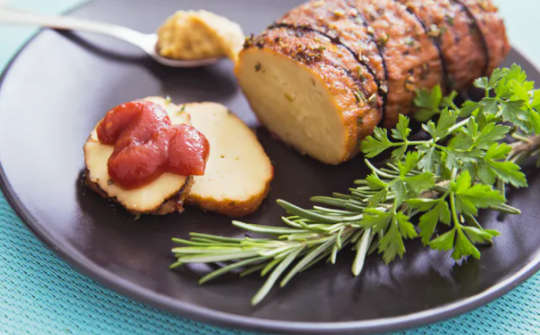 Shutterstock
Shutterstock
The trend towards vegetarian and vegan diets means more people are looking for meat-free protein alternatives.
Enter seitan (pronounced say-tan), the latest food trend that’s going viral online.
Seitan can be made by washing the starch off flour, so what you are left with is mainly gluten. Wheat gluten has been used as a substitute for meat in Asian countries for centuries, particularly among Buddhists who prefer not to eat meat. George Ohsawa, Japanese advocate for the “macrobiotic” diet, coined the term seitan for wheat gluten in the early 1960s.
Seitan’s versatility and “meatiness”, combined with the need for tasty, vegan protein options have contributed to its huge increase in popularity world-wide in recent years.
It’s high in protein and iron
As well as being flavoursome and reminiscent of meat, seitan is relatively high in protein and non-haem iron compared to other vegetarian protein foods.
One serving around the size of the palm of your hand contains about 75 grams of protein, enough for most adults for a day. Gram for gram, that’s about three times as much protein as beef or lamb.
With about 5 milligrams of iron per 100 grams, seitan has as much iron as kangaroo meat or beef. But as for other plant-based foods, the non-haem iron in seitan is not as readily absorbed as the haem iron in meats.
A small serve of seitan (100 grams) contains about 14 grams of carbs, which is about the same as one slice of bread.
Seitan doesn’t contain any soy, unlike tofu or tempeh. So it’s a good option for people with a soy allergy.
You can make it at home
You can make seitan just from flour and water, but it does take about an hour from start to finished product.
To prepare seitan, combine flour with a little salt and water to form a soft dough. Then keep kneading the dough under cold running water (to remove the starch) until it becomes a very stiff and stretchy dough.
If you’re in a hurry, you can cheat by mixing commercially available “vital wheat gluten” with water.
Either way, once you’ve got the gluten dough, flavour it with spices or sauces and then pan fry or boil it.
You can serve it as a steak substitute, sliced and stir-fried, “pulled” like pork, or crumbed and made into a vegan schnitzel. Seitan meals have been known to be mistaken as meat by some fairly serious carnivores!
It might be worth taste testing ready-made seitan from a shop to check whether you like it before making it yourself, but this often contains added salt as a preservative. Make sure the sodium content is under 400 milligrams per 100 grams. It’s a good idea to limit your sodium intake, and the Heart Foundation recommends no more than 2,000 milligrams per day.
So what’s the downside?
Well, it’s definitely not suitable for people diagnosed with coeliac disease or with a known adverse reaction to the gluten proteins in wheat.
If that’s you, then tofu and legumes are suitable meat substitutes. Another sustainable, gluten-free option is Quorn, a protein-rich food made by fungi.
If you get a bloated tummy or gut pain after eating bread or pasta, but definitely don’t have coeliac disease, it would be interesting to know whether you tolerate seitan. If you do, it could be you don’t tolerate the carbohydrate part of wheat, but can tolerate gluten. A research team at the University of Newcastle, of which I am a part, is investigating whether people who report gut pain after eating wheat are sensitive to the gluten or to the fermentable carbohydrates (FODMAPs) in wheat.
For everyone else who wants to decrease or avoid meat, seitan is versatile and one of the closest in texture and flavour to meat of any vegetarian protein options — so break out the mixing bowls and get kneading.
About The Author
Kerith Duncanson, Senior Research Fellow, School of Medicine and Public Health, University of Newcastle
This article is republished from The Conversation under a Creative Commons license. Read the original article.

Related Books:
Salt, Fat, Acid, Heat: Mastering the Elements of Good Cooking
by Samin Nosrat and Wendy MacNaughton
This book offers a comprehensive guide to cooking, focusing on the four elements of salt, fat, acid, and heat and offering insights and techniques for creating delicious and well-balanced meals.
Click for more info or to order
The Skinnytaste Cookbook: Light on Calories, Big on Flavor
by Gina Homolka
This cookbook offers a collection of healthy and delicious recipes, focusing on fresh ingredients and bold flavors.
Click for more info or to order
Food Fix: How to Save Our Health, Our Economy, Our Communities, and Our Planet--One Bite at a Time
by Dr. Mark Hyman
This book explores the links between food, health, and the environment, offering insights and strategies for creating a healthier and more sustainable food system.
Click for more info or to order
The Barefoot Contessa Cookbook: Secrets from the East Hampton Specialty Food Store for Simple Entertaining
by Ina Garten
This cookbook offers a collection of classic and elegant recipes from the beloved Barefoot Contessa, focusing on fresh ingredients and simple preparation.
Click for more info or to order
How to Cook Everything: The Basics
by Mark Bittman
This cookbook offers a comprehensive guide to cooking basics, covering everything from knife skills to basic techniques and offering a collection of simple and delicious recipes.

























